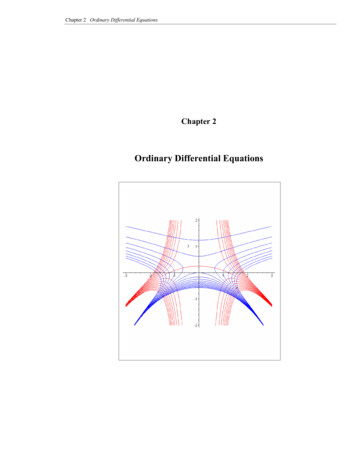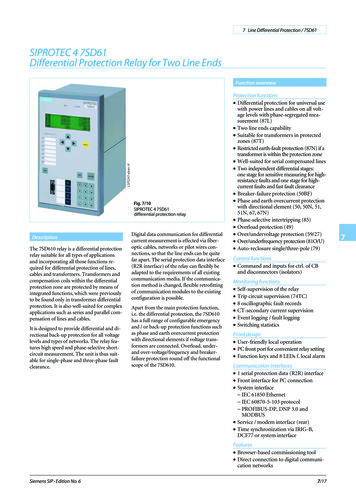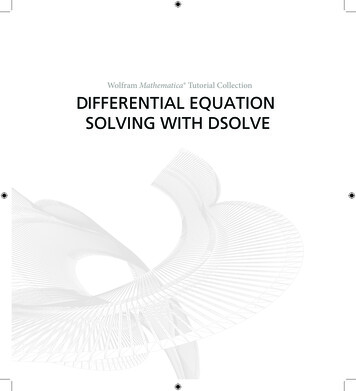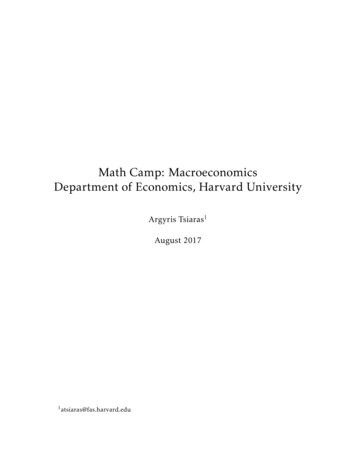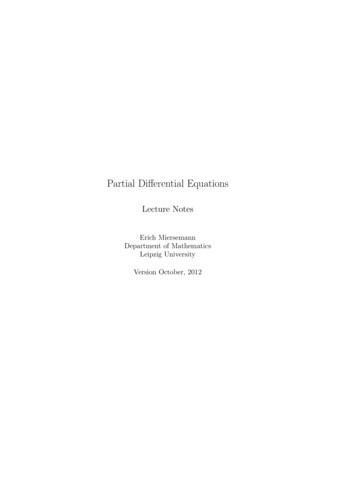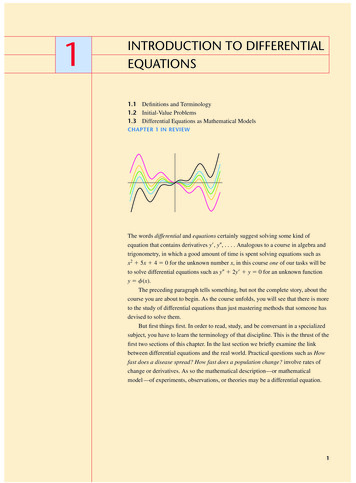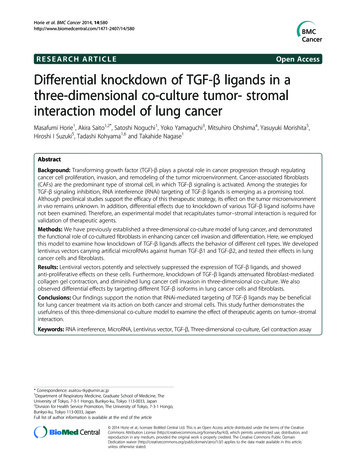
Transcription
Horie et al. BMC Cancer 2014, 0RESEARCH ARTICLEOpen AccessDifferential knockdown of TGF-β ligands in athree-dimensional co-culture tumor- stromalinteraction model of lung cancerMasafumi Horie1, Akira Saito1,2*, Satoshi Noguchi1, Yoko Yamaguchi3, Mitsuhiro Ohshima4, Yasuyuki Morishita5,Hiroshi I Suzuki5, Tadashi Kohyama1,6 and Takahide Nagase1AbstractBackground: Transforming growth factor (TGF)-β plays a pivotal role in cancer progression through regulatingcancer cell proliferation, invasion, and remodeling of the tumor microenvironment. Cancer-associated fibroblasts(CAFs) are the predominant type of stromal cell, in which TGF-β signaling is activated. Among the strategies forTGF-β signaling inhibition, RNA interference (RNAi) targeting of TGF-β ligands is emerging as a promising tool.Although preclinical studies support the efficacy of this therapeutic strategy, its effect on the tumor microenvironmentin vivo remains unknown. In addition, differential effects due to knockdown of various TGF-β ligand isoforms havenot been examined. Therefore, an experimental model that recapitulates tumor–stromal interaction is required forvalidation of therapeutic agents.Methods: We have previously established a three-dimensional co-culture model of lung cancer, and demonstratedthe functional role of co-cultured fibroblasts in enhancing cancer cell invasion and differentiation. Here, we employedthis model to examine how knockdown of TGF-β ligands affects the behavior of different cell types. We developedlentivirus vectors carrying artificial microRNAs against human TGF-β1 and TGF-β2, and tested their effects in lungcancer cells and fibroblasts.Results: Lentiviral vectors potently and selectively suppressed the expression of TGF-β ligands, and showedanti-proliferative effects on these cells. Furthermore, knockdown of TGF-β ligands attenuated fibroblast-mediatedcollagen gel contraction, and diminished lung cancer cell invasion in three-dimensional co-culture. We alsoobserved differential effects by targeting different TGF-β isoforms in lung cancer cells and fibroblasts.Conclusions: Our findings support the notion that RNAi-mediated targeting of TGF-β ligands may be beneficialfor lung cancer treatment via its action on both cancer and stromal cells. This study further demonstrates theusefulness of this three-dimensional co-culture model to examine the effect of therapeutic agents on tumor–stromalinteraction.Keywords: RNA interference, MicroRNA, Lentivirus vector, TGF-β, Three-dimensional co-culture, Gel contraction assay* Correspondence: asaitou-tky@umin.ac.jp1Department of Respiratory Medicine, Graduate School of Medicine, TheUniversity of Tokyo, 7-3-1 Hongo, Bunkyo-ku, Tokyo 113-0033, Japan2Division for Health Service Promotion, The University of Tokyo, 7-3-1 Hongo,Bunkyo-ku, Tokyo 113-0033, JapanFull list of author information is available at the end of the article 2014 Horie et al.; licensee BioMed Central Ltd. This is an Open Access article distributed under the terms of the CreativeCommons Attribution License (http://creativecommons.org/licenses/by/4.0), which permits unrestricted use, distribution, andreproduction in any medium, provided the original work is properly credited. The Creative Commons Public DomainDedication waiver ) applies to the data made available in this article,unless otherwise stated.
Horie et al. BMC Cancer 2014, 0BackgroundLung cancer causes the deaths of more than one millionpeople worldwide every year [1]. Despite recent progressin molecular-targeted therapeutics, such as inhibitors ofepidermal growth factor receptor (EGFR) tyrosine kinaseand anaplastic lymphoma kinase (ALK), failure to achievelong-lasting therapeutic responses has emphasized theneed for novel treatment strategies [2,3].Most forms of cancer are associated with a stromalresponse and extracellular matrix (ECM) deposition,referred to as desmoplasia, which is critically regulatedby cancer-associated fibroblasts (CAFs) [4]. Cancer tissueremodeling allows tumor cells to grow and disseminate,and contributes to increased interstitial fluid pressure,which can be an obstacle to drug delivery [5].Among the soluble factors involved in the tumor–stromal interaction, transforming growth factor (TGF)-β playsa pivotal role. In premalignant stages, TGF-β acts as atumor suppressor by inhibiting proliferation and apoptoticinduction in epithelial cells. In later stages, epithelial cellsbecome refractory to the growth inhibitory effect of TGFβ and begin to secrete high levels of TGF-β, which in turnexhibits tumor-promoting activity, such as angiogenesis,immune evasion, fibroblast activation, and ECM accumulation [6-8]. Furthermore, TGF-β increases the migratoryand invasive capacity of cancer cells by inducing theepithelial–mesenchymal transition (EMT) [9,10]. Indeed,TGF-β levels in both serum and tissues were elevated andassociated with worsening prognosis in patients with lungcancer [11,12]. As such, TGF-β may be a promising targetfor cancer therapy. However, in contrast to cancer cells,the role of TGF-β signaling in the tumor stroma is poorlyunderstood, at least partly due to technical limitations indetecting TGF-β signaling activation in situ.RNA interference (RNAi) has been used widely to induce the potent and specific inhibition of gene expression. Several variants of small regulatory RNAs areinvolved in RNAi, including synthetic double-strandedsmall interfering RNAs (siRNAs), RNA polymerase III(pol III)-transcribed small hairpin RNAs (shRNAs), andendogenous or artificial microRNAs (miRNAs) that aretranscribed by RNA polymerase II (pol II) as pri-miRNA,and subsequently processed into mature miRNAs [13,14].Vectors that enable the expression of engineered miRNAsequences from Pol II promoters have been developed[15], in which the stem sequences of an endogenousmiRNA precursor are substituted with unrelated basepaired sequences that target specific genes.Among the therapeutic strategies for TGF-β signalinginhibition, RNAi is emerging as a promising tool [13].Recent advances in RNAi technology are overcomingprevious obstacles, such as instability in vivo, impededdrug delivery, and undesirable off-target effects. In animal experiments, RNAi agents directed against TGF-βPage 2 of 11ligands have successfully ameliorated outcomes in disease models [16], and raised hope that this approachmay be useful in a clinical setting.However, the three isoforms of TGF-β ligands—TGFβ1, TGF-β2, and TGF-β3—show different expression profiles in various tissues and cell types. To develop effectivetherapeutic strategies for silencing TGF-β ligands, identifying the appropriate isoform and target cell type maybe critical. To our knowledge, the differential effects ofeliminating specific TGF-β isoforms in a given tissuetype remain unstudied.In the present study, we explored the therapeuticeffect of TGF-β signaling blockade in lung cancer.We previously developed a three-dimensional (3D)co-culture model for evaluation of tumor–stromal interactions [17]. Using this model, we tested the differentialeffects of silencing TGF-β ligands in A549 lung cancercells and HFL-1 lung fibroblasts. Among the three isoforms of TGF-β ligands, TGF-β1 and TGF-β2 (but notTGF-β3) are dominantly expressed in these cells [18-20].Thus we established lentiviral vectors that transduce artificial miRNAs against human TGF-β1 and TGF-β2 as a toolfor testing the effects of TGF-β ligand knockdown.MethodsCell cultureTissue culture media and supplements were purchasedfrom GIBCO (Life Technologies, Grand Island, NY).A549 human lung adenocarcinoma cells and HFL-1human lung fibroblasts were purchased from the AmericanType Culture Collection (Rockville, MD), and were cultured in Dulbecco’s Modified Eagle’s Medium (DMEM)supplemented with 10% fetal bovine serum (FBS). Inaddition, 293FT cells were obtained from Invitrogen(Carlsbad, CA), and cultured in 100-mm dish coatedwith collagen type I (IWAKI, Tokyo, Japan) in DMEMwith 10% FBS and 1 mM sodium pyruvate.Artificial miRNA sequencesThe BLOCK-iT Pol II miR RNAi Expression Vector Kitwith EmGFP (Invitrogen, Carlsbad, CA) was used forRNAi experiments. The design of the expression vectorwas based on the use of endogenous murine miR-155flanking sequences. Artificial miRNA sequences targeting human TGF-β ligands were designed using BLOCKiT RNAi Designer (http://rnaidesigner.Invitrogen.com/rnaiexpress/). Four and three pairs of sense and antisense oligonucleotides were designed for targeting human TGF-β1 and β2, respectively (Additional file 1:Table S1).Plasmid construction and preparation of viral vectorsThe designed oligonucleotides were annealed, followedby ligation into the pcDNA6.2-GW/EmGFP-miR vector
Horie et al. BMC Cancer 2014, 0(Invitrogen), which facilitates transfer into a suitable destination vector via Gateway recombination reactions.The EmGFP forward sequence primer (5′- GGCATGGACGAGCTGTACAA 3′) was used for sequencing ofthe miRNA insert fragments, which was performedusing an ABI PRISM 310 Genetic Analyzer. As the control, pcDNA6.2-GW/EmGFP-miR negative control plasmid (Invitrogen) was used. The sequence containing themiRNA coding region was transferred to the lentivirusvector via the Gateway cloning system (Invitrogen).Briefly, the miRNA coding region was subcloned intothe entry plasmid pDONR221 (Invitrogen) using Gateway BP Clonase II Enzyme Mix (Invitrogen). The sequencesin the entry plasmids were then transferred to the lentiviral expression vector, pCSII-EF-RfA, using Gateway LRClonase II Enzyme Mix (Invitrogen).Lentivirus infectionThe recombinant lentivirus was produced by transfection of 293FT cells with the lentiviral expression vectors, pCMV-VSV-G-RSV-Rev, and pCAG-HIVgp, usingLipofectamine 2000 reagent (Invitrogen). After 72 h, themedium was collected, and 1 105 of A549 or HFL-1cells were infected with 500 μL of medium containinglentiviruses. For double knockdown of TGF-β1 andTGF-β2, 250 μL of each lentivirus-containing mediumwere used. Infection efficiency was assessed by measuring the percentage of EmGFP-positive cells via flow cytometry (EPICS XL System II; Beckman Coulter, Brea,CA), and knockdown efficiency of target gene was analyzed using an enzyme-linked immunosorbent assay(ELISA).RT-PCRTotal RNA was extracted using the RNeasy Mini Kit(Qiagen, Tokyo, Japan). The cDNA was synthesizedusing SuperScript III Reverse Transcriptase (Invitrogen),following the manufacturer’s protocol. Quantitativereverse transcription (RT)-PCR was performed usingMx-3000P (Stratagene, La Jolla, CA) and QuantiTectSYBR Green PCR (Qiagen). Relative mRNA expressionwas calculated using the ΔΔCt method, and expressionwas normalized to that of the glyceraldehyde 3-phosphatedehydrogenase (GAPDH) gene. The specific primers areshown in Additional file 2: Table S2.ELISA for TGF-β1 and TGF-β2A549 and HFL-1 cells were serum-starved for 24 h, andeach supernatant was collected. The concentrations ofTGF-β1 and TGF-β2 were measured using the Quantikine ELISA for human TGF-β1/TGF-β2 (R&D Systems,Minneapolis, MN), according to the manufacturer’s instructions. Each supernatant was activated by 1 N HCl,followed by neutralization with 1.2 N NaOH/0.5 M HEPES.Page 3 of 11The optical density of each reaction was measured at450 nm using a microplate reader (Bio-Rad, Hercules, CA),and corrected against absorption at 570 nm. Thedata were analyzed using the Microplate Manager IIIMacintosh data analysis software (Bio-Rad).Cell proliferation assayA549 cells were seeded at a density of 1 104/well on12-well dishes and HFL-1 cells were seeded at 4 104/well on 6-well dishes. Both cell types were cultured inDMEM containing 10% FBS. Cells were counted on days1, 3, and 5 after seeding using a hemocytometer.Collagen gel contraction assay and 3D co-cultureThree-dimensional gel cultures were carried out according to the previously published protocol [17]. Briefly,collagen gels were prepared by mixing 0.5 mL of fibroblast cell suspension ( 2.5 105 cells) in FBS, 2.3 mL oftype I collagen (Cell matrix type IA; Nitta Gelatin,Tokyo, Japan), 670 μL of 5 DMEM, and 330 μL of reconstitution buffer, following the manufacturer’s recommendations. The mixture (3 mL) was cast into eachwell of the six-well culture plates. The solution wasthen allowed to polymerize at 37 C for 30 min. Afterovernight incubation, each gel was detached and culturedin growth medium, and the surface area of the gels wasquantified via densitometry (Densitograph, ATTO, Tokyo,Japan) for 5 consecutive days, and the final size relative toinitial size was determined. For 3D co-culture, A549 cells(2 105) were seeded on the surface of each gel prior toovernight incubation. After 5 days of floating culture, thegel was fixed in formalin solution and embedded in paraffin, and vertical sections were stained with hematoxylinand eosin.StatisticsResults were confirmed by performing experiments intriplicate. Analyses were performed using JMP version9 (SAS Institute Inc., Tokyo, Japan). For statistical significance, differences between two experimental groupswere examined using Student’s t-test, and Dunnett’s testwas used for multiple comparisons with control group.P 0.05 was considered to indicate significance.GSEA (gene set enrichment analysis)Navab et al. reported gene expression profiles for 15 pairsof lung CAFs and NFs, and identified genes enriched inlung CAFs [21]. GSEA was performed using these microarray data sets (GSE22862) deposited in the public database. To obtain a gene set regulated by TGF-β, we usedpublicly available microarray datasets, derived from twolung fibroblast cell lines stimulated by TGF-β: HFL-1(GSE27597) and IMR-90 (GSE17518) [22,23]. We extracted the top 800 TGF-β-induced genes from each
Horie et al. BMC Cancer 2014, 0dataset, as identified through the Significance Analysisof Microarrays (SAM) method. Combining these twogene lists, we isolated 196 commonly induced genes intwo lung fibroblast cell lines, which were defined as‘TGF-β-regulated genes’ (Additional file 3: Table S3).ResultsTGF-β signaling is activated in lung CAFsCAFs are a major constituent of the tumor stroma, andwe have previously shown that lung CAFs are more potentin enhancing cancer cell invasion and collagen gel contraction than normal lung fibroblasts (NFs) [17]. Althoughthe role of TGF-β in cancer cells and lung fibroblasts hasbeen investigated extensively, TGF-β function in CAFsremains largely unknown due to technical hurdles inisolating fibroblasts from lung cancer tissues.To examine TGF-β signaling activation status in lungCAFs, we used gene set enrichment analysis (GSEA) todetermine whether the expression of the identified TGFβ-regulated genes was enhanced in lung CAFs comparedto NFs. This was performed using microarray data setsof CAFs and NFs reported by Navab et al. [21]. Theseanalyses demonstrated that the TGF-β-regulated genesidentified through our analysis are in fact highlyPage 4 of 11enriched in CAFs, suggesting that TGF-β signaling is activated in lung CAFs (Figure 1A). We further extracted88 ‘leading edge genes’ out of the TGF-β-regulatedgenes. A heatmap of these leading edge genes clearlyillustrated differential expression between CAFs andNFs (Figure 1B). As expected, ECM-related genes wereenriched among the leading edge genes, and a heatmap of16 selected ECM related genes apparently showed thatTGF-β-regulated ECM-related enzymes and substrates,including PLOD1, LOX, COL1A1, VCAN, SPARC, FN1,ELN, and THBS1, are more enriched in CAFs than NFs(Figure 1C).Lentivirus-mediated transduction of artificial miRNAsagainst human TGF-β1 and TGF-β2Based on the observation that endogenous TGF-β signaling is activated in lung CAFs, we examined whether TGFβ signaling activation in fibroblasts modulates the behaviorof adjacent cancer cells. We also aimed to elucidate thecell-autonomous action of TGF-β in lung cancer cells. Tothis end, we generated lentiviral vectors that transducedartificial miRNAs against TGF-β ligands, and tested theireffects on lung cancer cells and HFL-1 lung fibroblasts.The expression levels of TGF-β isoforms are variableFigure 1 Gene set enrichment analysis (GSEA). A: GSEA was used to examine the enrichment of identified TGF-β-regulated genes in CAFs.‘TGF-β-regulated genes’ include 196 genes induced by TGF-β in both IMR-90 and HFL-1 lung fibroblast cell lines. CAF and NF gene expressionprofiles reported by Navab et al. [21] were used. Enrichment of TGF-β-regulated genes is shown schematically with those that best correlated withthe CAF phenotype on the left (‘CAF-high’) and the genes that best correlated with the NF phenotype on the right (‘NF-high’). B: A heat maprepresenting the relative expression change of ‘ 88 leading edge genes’ which were obtained by GSEA analysis in CAFs and NFs. C: A heat maprepresenting the relative expression change of selected ‘16 ECM related genes’.
Horie et al. BMC Cancer 2014, 0among lung cancer cell lines. In order to survey these differences, we used Cancer Cell Line Encyclopedia (CCLE)data and found that expression of TGF-β isoforms arerelatively high in A549 cells among 111 non-small celllung cancer cell lines (Additional file 4: Figure S1). Therefore, we used A549 lung cancer cells in the followingexperiments.Four miRNA sequences were designed to target human TGF-β1, as well as three sequences against TGF-β2(Additional file 1: Table S1). Next, we determined the efficiency of lentiviral infection by measuring the percentage of EmGFP-positive cells using flow cytometry. Morethan 95% of A549 cells were positive for EmGFP, suggesting a high transduction efficiency for this miRNAsequence (Additional file 5: Figure S2A, left); we observed similar efficiencies for all miRNA sequences usedin this study (Additional file 5: Figure S2A, right).Meanwhile, HFL-1 cells showed more modest (but stillsufficient) efficiencies for lentiviral infection (Additionalfile 5: Figure S2B, left). The percentage of EmGFPpositive cells ranged from 65–85% among the miRNAsequences (Additional file 5: Figure S2B, right).For double knockdown of TGF-β1 and TGF-β2, twocombinations of lentiviruses encoding miRNAs againstTGF-β1 and TGF-β2 were co-infected: #2 miRNA againstTGF-β1 and #2 miRNA against TGF-β2 (TGF-β1KD #2 TGF-β2KD #2), or #4 miRNA against TGF-β1 and #3miRNA against TGF-β2 (TGF-β1KD #4 TGF-β2KD #3).Co-infection with two different lentiviruses showed similartransduction efficiencies compared to single infections, asdetermined via EmGFP fluorescence (Additional file 5:Figure S2A, right and Additional file 5: Figure S2B, right).Potent and selective knockdown of TGF-β1 and TGF-β2Next, we evaluated the efficiency of TGF-β knockdownthrough measurement of protein expression via ELISA.To control for unintended effects of experimental manipulation, we examined the expression of TGF-β1 andTGF-β2 in uninfected A549 and HFL-1 cells comparedto cells infected with negative control (NTC) miRNAs(Figure 2). No significant difference in TGF-β1 or TGF-β2expression was observed.In A549 cells, three of four miRNAs against TGF-β1(#1, #2, and #4) were able to silence TGF-β1 expression,whereas all three miRNAs against TGF-β2 were ineffectivefor TGF-β1 (Figure 2A, left). Two out of three miRNAsagainst TGF-β2 (#2 and #3) silenced TGF-β2 expression,whereas all four miRNAs against TGF-β1 were ineffectivefor TGF-β2 (Figure 2A, right). In HFL-1 cells, three offour miRNAs against TGF-β1 (#1, #2 and #3) were able tosilence TGF-β1 expression, whereas all three miRNAsagainst TGF-β2 were ineffective for TGF-β1 (Figure 2B,left). Two of three miRNAs against TGF-β2 (#2 and #3) silenced TGF-β2 expression, whereas all four miRNAsPage 5 of 11against TGF-β1 were ineffective for TGF-β2 (Figure 2B,right). These results show that miRNAs against TGF-β1or TGF-β2 exert their effects in a selective manner foreach ligand. Out of the two combinations tested fordouble knockdown, miRNA #2 against TGF-β1 and #2against TGF-β2 showed efficient silencing in both A549and HFL-1 cells (Figure 2). Therefore, we selected miRNAsequences #2 against TGF-β1 and #2 against TGF-β2, forsingle or double knockdown in the following experiments.Cell proliferation is suppressed by knockdown of TGF-β1and/or TGF-β2Next, we investigated whether TGF-β1 and/or TGF-β2knockdown affected the proliferation of A549 and HFL-1cells. In both cell types, the transduction of artificialmiRNAs against TGF-β1 or TGF-β2 suppressed cellproliferation (Figure 3), and this anti-proliferative effectwas enhanced in cells subject to double knockdown, compared to single knockdown of either TGF-β1 or TGF-β2.TGF-β is a strong inhibitor of proliferation in mostepithelial cells, whereas it promotes proliferation in mesenchymal cells and enhances cancer cell survival [6-8].Our lentivirus-mediated miRNA delivery system maintains stable knockdown of TGF-β1 and/or TGF-β2. Thismay alter cell signaling in the steady state and modulatethe cell machinery that regulates cell survival or proliferation, thereby resulting in suppressed cell proliferation.Altered EMT-related gene expression via TGF-β1 and/orTGF-β2 knockdownEMT is crucial for cancer cells to acquire invasive phenotypes, which are characterized by downregulation of Ecadherin and upregulation of vimentin. A549 cells stay inan intermediary state of EMT, whereas exogenous TGF-βfurther promotes acquisition of mesenchymal phenotypes[20]. We examined whether knockdown of TGF-β ligandsmodulated the expression of EMT markers.Silencing of TGF-β2 led to E-cadherin upregulation,suggesting the restoration of epithelial phenotypes. In accordance, vimentin expression was suppressed by knockdown of TGF-β1 and/or TGF-β2, though it failed to reachstatistical significance (Figure 4A). These results supportthe notion that endogenous TGF-β signaling participatesin the maintenance of a mesenchymal phenotype in A549cells in the steady state.EMT is accompanied by the enhanced expressionof fibrogenic growth factors, such as platelet-derivedgrowth factor (PDGF) and connective tissue growth factor (CTGF) [20]. PDGF is a dimeric protein composedof A and B subunits, and it has been reported that thetranscription of PDGFB is regulated by TGF-β. Consistent with the previous experiment [20], TGF-β2 silencingled to CTGF downregulation, whereas knockdown of
Horie et al. BMC Cancer 2014, 0Page 6 of 11Figure 2 Knockdown of TGF-β ligands. A: TGF-β1 and TGF-β2 concentrations measured by ELISA in the supernatant of A549 cells transducedwith each miRNA. Left: TGF-β1. Right: TGF-β2. Data shown are the means SEM of triplicate analyses. KD: knockdown. NTC: negative control. Theconcentration of TGF-β1 or TGF-β2 in the supernatant of cells with TGF-β1 and/or TGF-β2 knockdown was compared to that of cells transducedwith NTC miRNA. Statistical significance was determined by Dunnett’s test. *P 0.05. B: TGF-β1 and TGF-β2 concentrations measured by ELISA inthe supernatant of HFL-1 cells.TGF-β1 and/or TGF-β2 attenuated PDGFB expression(Figure 4B).Upon TGF-β stimulation, fibroblasts convert to an activated phenotype to enhance ECM production. Thus, weexamined whether knockdown of TGF-β1 and/or TGF-β2modulated the expression of α1 (I) collagen (COL1A1), amajor component of ECM. In HFL-1 cells, TGF-β1 knockdown decreased the expression of COL1A1, whereasTGF-β2 silencing had no effect (Figure 4C).These results suggest the differential regulation oftarget genes by TGF-β1 or TGF-β2 in cancer cells andfibroblasts. During lung branching morphogenesis,TGF-β1 expression is prominent throughout the mesenchyme, whereas TGF-β2 is localized to mainly theepithelium of the developing distal airways [24]. Thus,TGF-β2 may be critical for determining epithelial orcancer cell behavior in a cell-autonomous fashion,whereas endogenous TGF-β1 may play a greater role infibroblasts.TGF-β1 and/or TGF-β2 knockdown attenuates collagengel contraction in HFL-1 cellsCancer tissue contraction facilitates tumor progressionand contributes to increased interstitial fluid pressure,which hampers drug delivery [5]. The collagen gel contraction assay is used widely to recreate tissue contractionin an experimental setting, and it has been shown thatTGF-β stimulates fibroblast-mediated collagen gel contraction [25]. We used this assay to investigate whetherknockdown of TGF-β1 and/or TGF-β2 modulated tissuecontraction through effects on fibroblasts.Collagen gels were embedded with HFL-1 cells afterTGF-β1 and/or TGF-β2 knockdown, and gel size wasmeasured daily. On the first day, the control gel size wasreduced to 50% of the initial value, followed by gradualshrinkage to less than 20% on the fifth day (Figure 5).Compared to the control, knockdown of TGF-β1 and/orTGF-β2 in HFL-1 cells attenuated gel contraction (Figure 5and Additional file 6: Figure S3). These results suggested
Horie et al. BMC Cancer 2014, 0Page 7 of 11Figure 3 Cell proliferation assay. Cell proliferation curve in A549 or HFL-1 cells transduced with NTC miRNA (solid line) compared to cells transducedwith miRNA against TGF-β1 (dashed line: TGF-β1 KD), TGF-β2 (dotted line: TGF-β2 KD), or TGF-β1 and TGF-β2 (dashed-dotted line: TGF-β1 β2 KD). Cellcounts were carried out on days 1, 3, and 5 after seeding. Left: A549. Right: HFL-1. Data shown are the means SEM of triplicate analyses. Numbers of cellswith TGF-β1 and/or TGF-β2 knockdown on day 5 was compared to that in the cells transduced with NTC miRNA. Statistical significance was determinedby Student’s t-test. *P 0.05.that the inhibition of endogenous TGF-β signaling infibroblasts ameliorates tissue contraction.Three-dimensional co-culture of A549 and HFL-1 cellsTo examine the interaction between lung cancer cellsand fibroblasts, we previously established a 3D co-culturemodel [17]. HFL-1 cells transduced with control miRNAsor those for TGF-β1 and TGF-β2 silencing (double knockdown) were embedded into the collagen gels, and thenA549 cells were seeded onto the surface of these gels. Theco-cultured collagen gels were subjected to floating culture for an additional 5 days, followed by hematoxylin andeosin staining (Figure 6).Double knockdown of TGF-β1 and TGF-β2 in HFL-1cells did not show clear effects on A549 cell invasion,suggesting a minor role for TGF-β produced in HFL-1cells in this co-culture model (lower panels). In ourprevious work, we did not examine whether HFL-1cells enhance lung cancer cell invasion [17], and thisstudy suggests that endogenous TGF-β expression inHFL-1 cells may not have a significant role in invasionpromotion.In contrast, A549 cell invasion was observed whencontrol A549 cells were cultured with control HFL-1cells (upper left panel). Silencing of either TGF-β1 orTGF-β2 in A549 cells failed to inhibit invasion (uppermiddle panels), whereas double knockdown of TGF-β1and TGF-β2 led to complete disappearance of invadingcells (upper right panel).DiscussionTGF-β plays several crucial roles in cancer progression,affecting both tumor and stromal cells, including fibroblasts [4]. However, very little is known regardingthe effects of TGF-β ligand silencing in the contextof tumor–stromal or epithelial–mesenchymal interactions [26]. Numerous reports have shown the effectsof exogenous TGF-β stimulation in various cell types,whereas the effects of endogenous or cell-autonomousTGF-β signaling are poorly understood. To our knowledge, this study is the first to generate lentiviral vectorsencoding artificial miRNAs targeting human TGF-β1 andTGF-β2, and to explore their effects in a co-culturemodel.Lentiviral vectors showed efficient transduction in A549lung cancer cells, as well as HFL-1 lung fibroblasts.Knockdown efficiency to less than 30% of the control wasobtained for both TGF-β1 and TGF-β2 in a selectivemanner. Knockdown of TGF-β ligands suppressed cellproliferation in both A549 and HFL-1 cells. Furthermore,expression of EMT markers and fibrogenic growth factorswas modulated in A549 cells, whereas collagen I wasdownregulated in HFL-1 cells. With regard to cellularfunction, silencing of TGF-β ligands attenuated HFL-1mediated collagen gel contraction, and inhibited A549 cellinvasion in the 3D co-culture model. All of these findingssupport the tumor-promoting role of TGF-β, and thatthe reported beneficial effects of TGF-β inhibition incancer therapeutics may derive from interfering withtumor–stromal communications.
Horie et al. BMC Cancer 2014, 0Page 8 of 11Figure 4 Quantitative RT-PCR. A: Quantitative RT-PCR for E-cadherin (left) and vimentin (right) in A549 cells. B: Quantitative RT-PCR for CTGF(left) and PDGFB (right) in A549 cells. C: Quantitative RT-PCR for COL1A1 in HFL-1 cells. Data shown are the means SEM. The relative expressionof each gene in cells with TGF-β1 and/or TGF-β2 knockdown was compared to that in the cells transduced with NTC miRNA. Statistical significancewas determined by Student’s t-test. *P 0.05.In our experiments, it appeared that both TGF-β1 andTGF-β2 were abundantly produced in A549 cells, whereasthe concentration of TGF-β1 was higher than that ofTGF-β2 in the supernatant of HFL-1 cells. Compared tosingle knockdown, double knockdown of TGF-β1 andTGF-β2 showed stronger effects in A549 cell proliferationand invasion in a 3D co-culture. In HFL-1 cells, TGF-β1knockdown was more effective than TGF-β2 knockdownin suppressing COL1A1 expression.Little is known regarding the expression profiles ofTGF-β isoforms in various lung cancer cell types. Asshown here, knockdown of each TGF-β ligand
Horie et al. BMC Cancer 2014, 14:580http://
using an ABI PRISM 310 Genetic Analyzer. As the con-trol, pcDNA6.2-GW/EmGFP-miR negative control plas-mid (Invitrogen) was used. The sequence containing the miRNA coding region was transferred to the lentivirus vector via the Gateway cloning system (Invitrogen). Briefly, the miRNA coding region was subcloned into the entry plasmid pDONR221 (Invitrogen) using Gateway BP Clonase II Enzyme .



